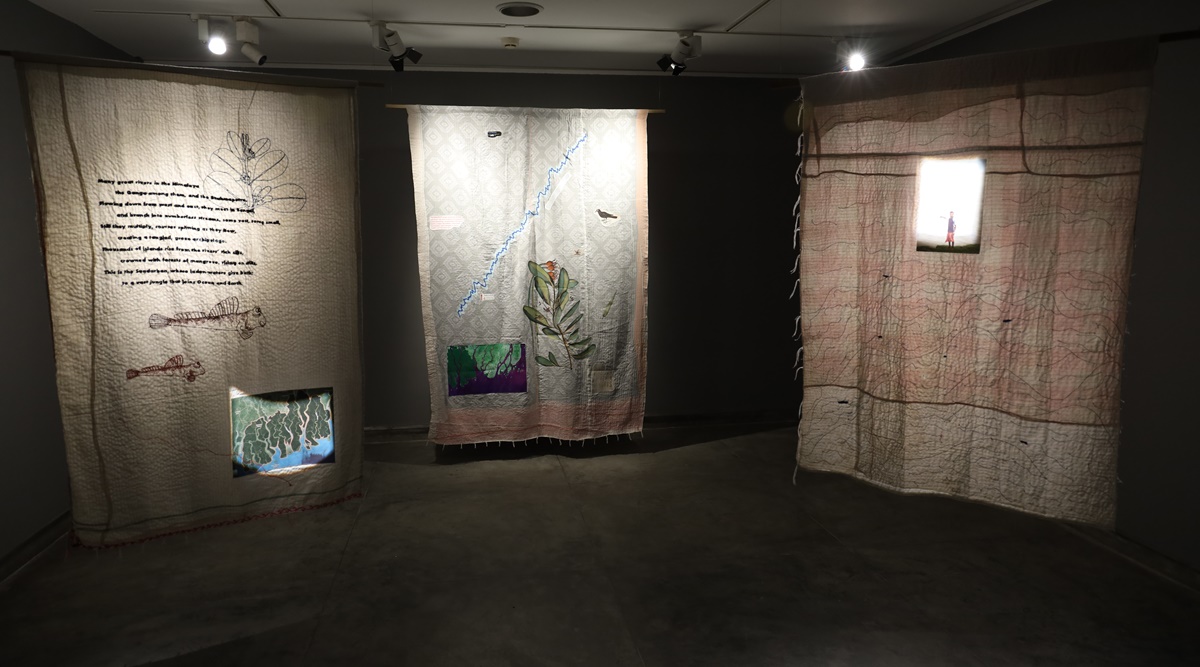📣 For more lifestyle news, click here to join our WhatsApp Channel and also follow us on Instagram
In her debut solo, Ishita Chakraborty highlights the fragile landscape of Sunderbans
Featuring works in various mediums, the exhibition at Gallery Espace in Delhi also tells stories rooted in the mangrove forests and documents voices of its inhabitants
 The ongoing exhibition was either made or evolved earlier this year during her month-long stay in a remote island in the Sunderbans mangrove forest called Satjelia. (Picture credit: Author)
The ongoing exhibition was either made or evolved earlier this year during her month-long stay in a remote island in the Sunderbans mangrove forest called Satjelia. (Picture credit: Author)THE intertwining of politics and art isn’t new for Ishita Chakraborty, the 33-year-old multimedia artist from Kolkata who is currently exhibiting her first solo show titled “Sleeping in the Bed of Salt” at Gallery Espace in Delhi. It started when she was a young girl growing up in Kolkata, who was reminded of her complexion being “too dark”. It grew with time, more so when she went to Switzerland, first in 2017 for a six-month art residency, and again in 2018. Suddenly, a series of labels were attached to her identity — a minor, a woman of colour, an Asian woman, a young woman, among others.
Once there, Chakraborty also joined a migrant education programme, which taught German, Swiss and other languages for free to immigrants to polish her language. “I connected with a lot of immigrants. Surprisingly, it is in the confinement of that room that I and the colour of my skin felt more seen than it did in the whole country,” says the artist whose recurring subjects include displacement, race, identity and migrants. Over the years she has been honoured with several awards, including the Visiting Artist Fellowship at SAI, Harvard University (2020-21), and received a project grant from the Swiss Arts Council Pro Helvetia.
 Tapestries featuring Kantha embroidery work co-created by fisherwomen of Sunderbans.
Tapestries featuring Kantha embroidery work co-created by fisherwomen of Sunderbans.
The ongoing exhibition was either made or evolved earlier this year during her month-long stay in a remote island in the Sunderbans mangrove forest called Satjelia. It sees Chakraborty using various mediums, from a series of small cyanotype prints capturing the movement of water to tapestries co-created with the fisherwomen community featuring kantha embroidery. Several stories are told and a song is dedicated to the goddess/protector of the forest, Bonbibi. The translated version of the song embroidered here is from Amitav Ghosh’s Jungle Nama. Alongside, Chakraborty also presents her poetry from where she borrows the title of this exhibition, terracotta pottery and a larger-than-life drawing representing rhizome roots. A video shows her being ferried across the vast openings of the Matla and Bidyadhari rivers as a fisherwoman’s voice singing a song dedicated to Bonbini transports the viewers to Sunderbans.
It was her interest in the subject of migration that made Chakraborty take her maiden trip to Sunderbans — a mangrove area in the delta formed by the confluence of the Ganges, Brahmaputra and Meghna Rivers in the Bay of Bengal — in 2020. She has been taking an annual trip there since then. “At first it was me – an urban woman – in Sunderbans,” says the artist who lives and works between Switzerland and India. Over the years, she has been a witness to portions of land submerging into the water.
Calling French philosopher-poet Édouard Glissant her inspiration, she acknowledges using his concept of relation to artistically translate the movement of water. “Thereafter comes his philosophy of rhizome (an underground plant stem capable of producing the shoot and root systems of a new plant) where every identity is extended through a relationship with the other, implying that it is a place where different cultures and origins can meet and connect. Sunderban is a land where one can see these rhizome roots, and it was the interconnectedness with nature that fascinated me,” adds Chakraborty who used a similar theory for her mushroom installation titled “Europa”, which has thousands of mushrooms — a result of multiple participatory workshops where refugees and migrants engaged in crafting mushrooms — representing migrants, who in Chakraborty’s words ‘migrate and grow wherever they find nutrients’. The work led to an invitation by the Swiss art museum Aargauer Kunsthaus (2021) for their annual exhibition in 2022.
Her time in Sunderbans also made Chakraborty understand and appreciate eco-feminism, a term she insists is the need of the hour. “In terms of hierarchy, we see women who didn’t receive institutional knowledge, we don’t always take them seriously. But in Sunderbans, I realised the true strength of women,” she says, adding that in this part of the country most men migrate to nearby islands or places to work as daily wage labourers and women manage the chores. “These women do everything, from fishing and rowing boats to running the household and the economy in a way. At the same time, some of these fisherwomen go from one village to another to perform the Bonbini song so they are also performers and protectors of the forest considering the narrative asks people to get a grip over human greed,” she says, adding, “If you go back in history, you will see the women and nature both being marginalised and oppressed for a long time and the term brings us close to the reality and their role, and how they build and function in a community.”
📣 For more lifestyle news, follow us on Instagram | Twitter | Facebook and don’t miss out on the latest updates!
📣 For more lifestyle news, click here to join our WhatsApp Channel and also follow us on Instagram
Photos



- 01
- 02
- 03
- 04
- 05
























